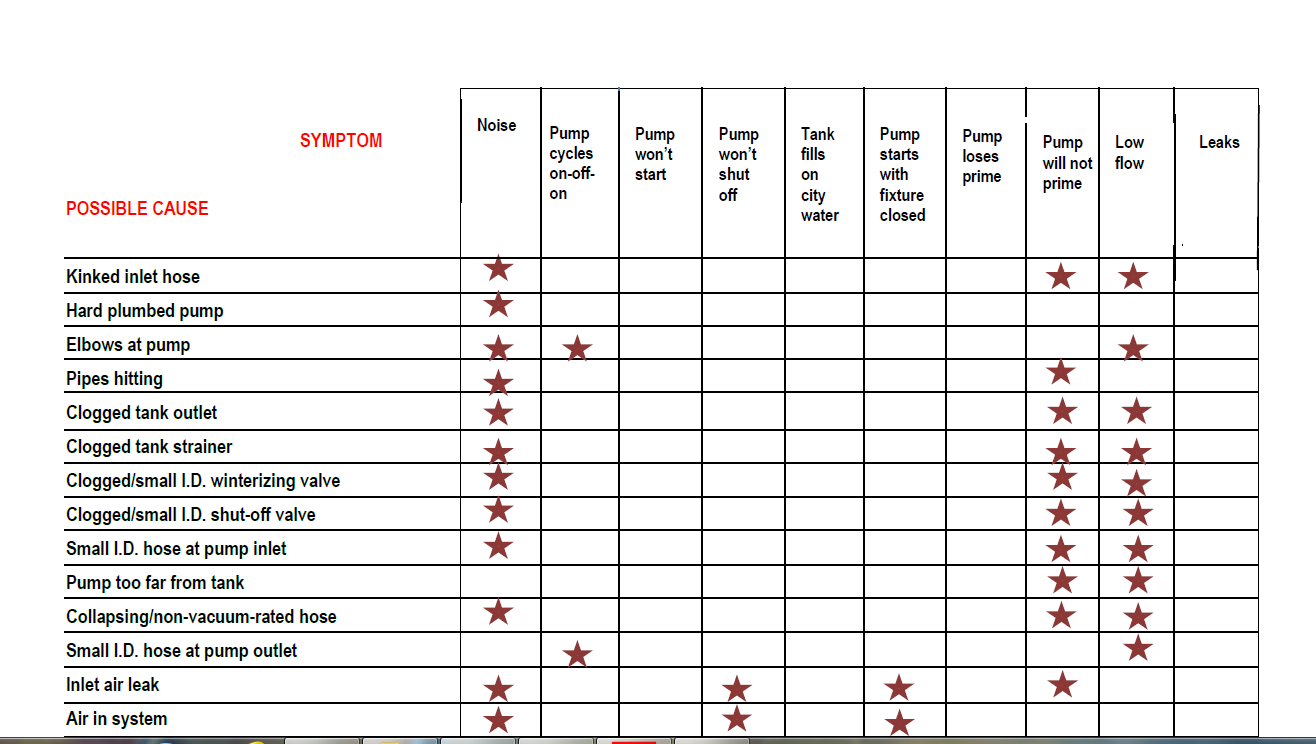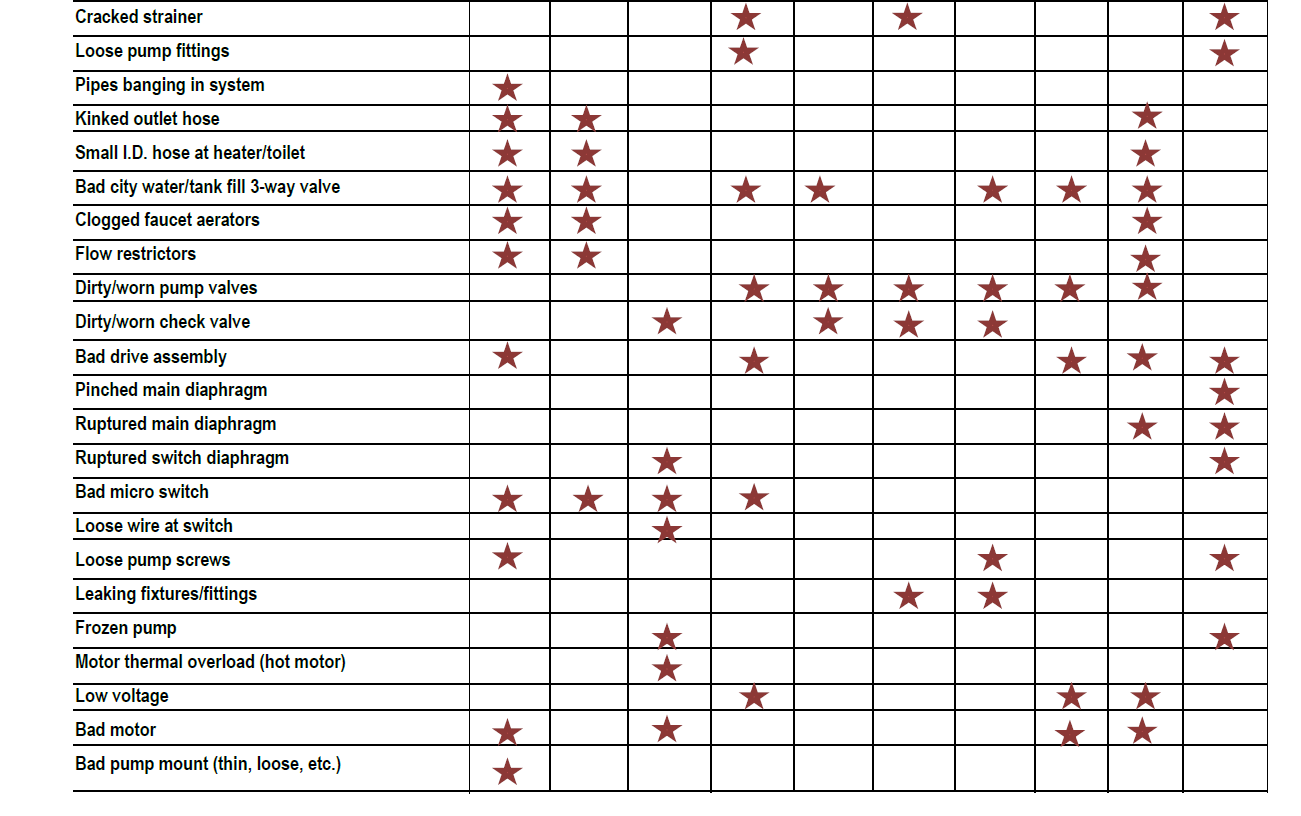T R O U B L E S H O O T I N G
Driving-induced vibrations can loosen plumbing, strainers and pump hardware.
Check for loose system components--many symptoms can be resolved by simply tightening the hardware. Check the following items, along with other particulars of your system.
Pump won’t start/ blows circuit:
* Check electrical connections, fuse or breaker, main switch, and ground connection.
* Is the motor hot? The internal thermal breaker may have triggered; it will reset when cool.
* Is voltage present at the pressure switch? Bypass the pressure switch. Does the pump operate?
* Check the charging system for correct voltage (±10%) and good ground.
* Check for an open or grounded circuit, or motor; or improperly-sized wire.
* Check for a seized or locked diaphragm assembly (water frozen?).
Noisy or rough operation:
* Check for plumbing which may have vibrated loose.
* Check for a restricted inlet (clogged strainer, kinked hose, restrictive valves).
* Is the pump plumbed with rigid pipe causing noise to transmit?
* Does the mounting surface amplify noise (flexible)? Does it bang like a drum?
* Check for mounting feet that are loose or compressed too tight.
* Check for air in the system. Check all fixtures for air and bleed system.
* Check the motor with pump head removed. Is noise coming from the motor or the pump head?
Leaks from pump head or switch:
* Check for loose screws at switch or pump head.
* Is the switch diaphragm ruptured or pinched?
* Check for a punctured diaphragm if water is present in the drive assembly.
Rapid cycling (pump turns on and off rapidly while running):
* Check for restrictive plumbing and flow restrictions in faucets/shower heads.
* Water filter/purifier should be on a separate feed line.
* Check for clogged faucet aerators or shower heads from debris or hardness build-up.
Pump won’t shut off or runs when faucet is closed:
* Check the output side (pressure) plumbing for leaks, and inspect for leaky valves or toilet.
* Check for air trapped in outlet side (water heater) or pump head.
* Check for correct voltage to pump (±10%).
* Check for loose drive assembly or pump head screws.
* Are the pump valves held open by debris or is the rubber swollen?
* Check for a bad city water/tank fill valve.
* Check the pressure switch operation.
* Check to see if the by-pass pressure is set higher than shut-off pressure.
Won’t prime/sputters (no discharge/motor runs):
* Is the strainer clogged with debris? Some systems have a strainer inside the tank.
* Is there water in the tank, or has air collected in the hot water heater?
* Is the inlet tubing/plumbing sucking in air at plumbing connections (vacuum leak)?
* Is the inlet/outlet plumbing severely restricted or kinked? Check for any restrictive or clogged winterizing valves.
* Check for proper voltage with the pump operating (±10%).
* Check for a bad city water/tank fill valve.
* Check for debris in pump inlet/outlet valves or swollen/dry valves.
* Check the pump housing for loose screws, cracks or loose drive assembly screws.
* Check for a stuck check valve.
S A N I T I Z I N G
Potable water systems require periodic maintenance to keep components working properly and deliver a consistent flow of fresh water.
Sanitizing is recommended before storing and also before using the water system after a period of storage.
Systems with new components, or ones that have been subjected to contamination, should also be disinfected as follows.
[NOTE: Check your vehicle owner’s manual for specific instructions.]
1. Use one of the following methods to determine the amount of common household bleach needed to sanitize the tank.
a) Multiply the tank gallon capacity by 0.13 for the number of ounces of bleach needed to sanitize the tank. Example: An 80 gallon tank requires 10.4 ounces of bleach.
b) Multiply tank liter capacity by 1.0 for the number of millimeters of bleach needed to sanitize the tank. Example: A 300-liter tank requires 300 milliliters of bleach.
2. Mix the bleach with water in a pourable container such as a gallon jug. If tank is filled through a pressurized fitting, carefully pour the bleach into the hose before attaching the hose to the city water entry.
3. Pour the bleach solution into the tank and fill the tank with potable water.
4. Open all faucets (hot and cold) allowing the water to run until the odor of chlorine is detected. Now the system must sit to let the disinfectant work.
The system must have four hours of contact time to disinfect completely. Doubling the solution concentration allows for a shorter contact time of one hour.
When the contact time is completed, drain the tank. Refill the tank and flush the system once or twice until the odor has decreased. The residual chlorine odor and taste is not harmful.
W I N T E R I Z I N G
If water is allowed to freeze in the system, serious damage to the plumbing and the pump may occur. Failures of this type will
void the warranty. The best guarantee against damage is to completely drain the pump.
NOTE: When used according to the manufacturer’s recommendations, non-toxic antifreeze for potable water is safe for use with SHURflo pumps. It’s always best to refer to the vehicle owner’s manual for specific winterizing instructions.
WARNING: Do not use automotive antifreeze to winterize potable water systems. Such solutions are highly toxic. Ingestion may cause serious injury or death. To properly drain the pump, perform the following:
1. Drain the water tank. If the tank doesn't have a drain valve, open all faucets allowing the pump to operate until the tank is empty.
2. Open all the faucets (including the lowest valve or drain in the plumbing), allow the pump to purge the water from the plumbing, and then turn the pump OFF.
3. Using a pan to catch the remaining water, remove the plumbing at the pump's inlet/outlet ports. Turn the pump ON, allowing it to operate until the water is expelled.
Turn OFF power to the pump once the plumbing is emptied. Do not reconnect pump plumbing. Make a note at tank fill as a reminder: "Plumbing is disconnected".
4. All faucets should be left open to guard against any damage.
5. Potable anti-freeze may be poured down drains and toilets to protect p-traps and toilet seals.
6. Be sure to sanitize the system when done with winter storage.

